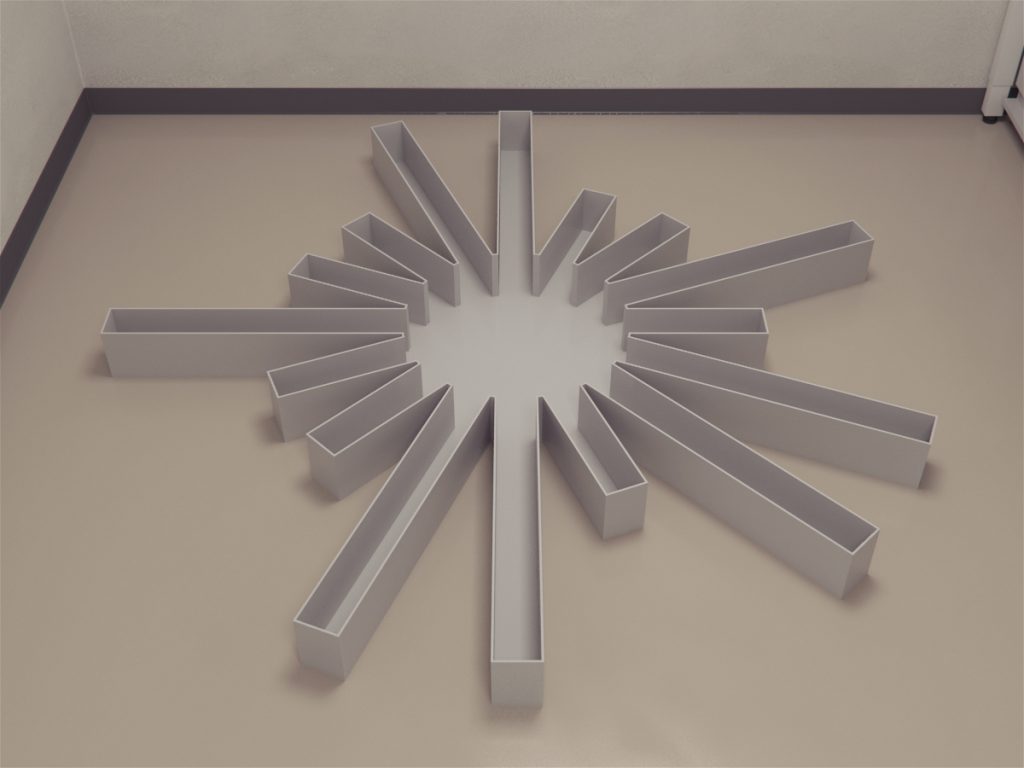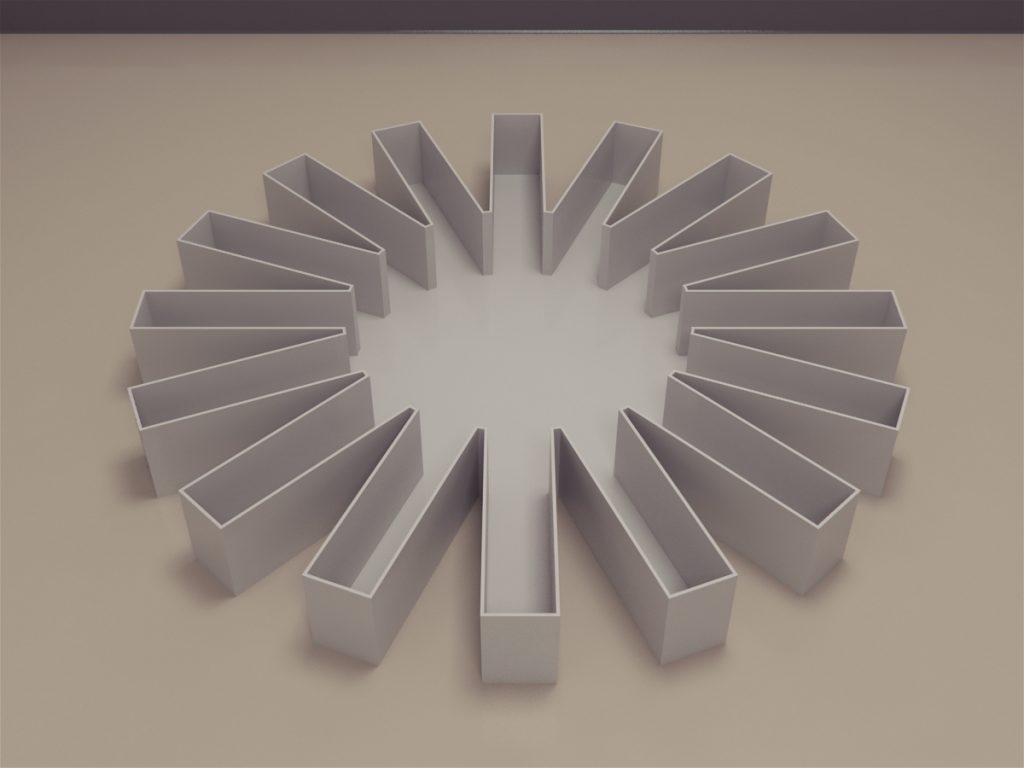Description
Olton and Samuelson’s (1978) Radial Arm Maze (RAM) has seen many variations and modification since its initial use. Investigators have experimented with changing the number of arms to increase and decrease the difficulty of the Radial Arm Maze task. Another simple modification is changing the length of the arms. Typically, radial arm mazes utilize arm lengths of 80 cm. However, the length of the arms could potentially influence the performance of the subjects.
Inquire
Effect of arm length on Radial Arm Maze performances
Researchers have speculated if the length of the arms of Radial Arm Maze could have a possible influence on the performance of the maze task. In his paper, Brown (1990) tested this speculation by testing the subjects in RAMs with shorter and longer arm lengths. For his investigation, he used a 12-arm Radial Arm Maze that was baited at either 37 cm length (short arm scenario) or the standard 80 cm length. Two RAM protocols were used; Free-choice trials and Forced-choice trials. For both the trials and length configurations, subjects naïve to the task were used.
For free-choice trials, the subjects were allowed to explore the entire maze until 12 arms had been visited, 24 choices had been made, or 10 min had elapsed. During this trial, subjects assigned to the short-arm configuration never ventured beyond the 37 cm mark, where the food rewards were placed.
In the forced-choice trials, designed to disrupt response bias, subjects were placed in the Radial Arm Maze with only access to only one arm after 5 seconds of introduction. While the subject visited the available arm, the door to another arm was opened. On visiting the second open arm, entry to the first arm was closed, and the entry to another arm was opened. This process was repeated till six randomly chosen arms were visited by the subjects. On completion of this task, the subjects were reintroduced to the maze after a delay period. In this trial all 12 alleys were available, however only the unvisited arms were baited. The trial lasted until all the baited arms were visited or 10 minutes had elapsed.
Analysis of the two trials revealed that in the free-choice trials the short-arm group was not relying on their working memory to perform the task, unlike the long-arm group. The short-arm group simply visited the adjacent arms till all arms had been visited. In the forced-choice trials, the long-arm group was more successful than the short-arm group in visiting the unvisited arms.
Brown further investigated the difference in the short-arm and long-arm performances by using a 16-arm Radial Arm Maze that had a heterogeneous mix of short and long arms. The observation of the previous investigation suggested that the short-arm set-up, in comparison to the standard length, resulted in lower levels of accuracy and higher levels of response stereotypy. With the new configuration of the RAM, Brown attempted to distinguish poor working memory from poor choice accuracy/response stereotypy.
The subjects were tested in two procedures. First in a free-choice trial and then in two-alternative forced-choice trials. In the two-alternative forced-choice procedure subjects 8 arms were randomly chosen and blocked. The remaining arms were baited. The subject was the allowed to explore all the open arms after which it was held in its home cage for 15 minutes. The subjects were reintroduced into the maze but were allowed access to only two arms; previously blocked arm (baited) and previously unblocked arm (un-baited). Subjects were given 10 minutes to make the choice after which they were removed from the maze and held for an inter-trial delay of 5 seconds. The process was repeated till all possible pairs of arms were exhausted. During all the trials of unblocked arms, it was ensured that every pair was of the same length, that is, subjects were always given a choice between either two long arms or two short arms.
Free-choice data analysis showed that the subjects tended to visit shorter arms independent of the ability to discriminate previous visits as a function of arm length and the ordinal position of initial arm visit. On the other hand, the two-alternative forced-choice trials data provided no evidence to support that there was any difference in the ability to discriminate previously visited and unvisited arms as a function of arm length.
Are you an academic scientist and creator?
Learn how your lab can tech transfer this and similar devices from your lab to industry.
Choice-criterion difference or Discriminability difference?
The results of the experiments conducted by Brown (1990) suggested the bias towards short arms could be the effect of either the diminished discriminability of arm visits when arms are short or a relatively lax choice criterion applied to the short arms in a Radial Arm Maze.
Brown in collaboration with Huggins (1993) further investigated the possibility of application of lax choice criterion by the subjects in response to short arms in the maze. For this purpose, they analyzed the microstructure of choices by application of signal detection theory. The experiments were performed in a 12 arm Radial Arm Maze that had six arms of length 80 cm and the rest of length 40 cm. Two independent coders, naïve to the investigation, coded the data of the experiments. The first coder (Coder A) coded all 25 sessions, while the second coder (Coder B) coded the last 10 sessions to allow interrater reliability measures. A micro-choice to the coders was defined as “clear orientation toward the end of an arm that was accompanied either by a discernable stop in the motion of the rat or by a macro-choice” (Brown and Huggins, 1993). Coder A’s data was also used to determine hit rate and correct rejection rate to long and short arms. Free-choice and forced-choice trials were performed similarly as in Brown (1990).
The experiment by Brown and Huggins was able to replicate the choice accuracy of the previous experiments; however, the magnitude of the experiments appeared lower in the current experiment. Analysis of the Radial Arm Maze performance in the forced-choice task suggests that a choice criterion difference mediates the difference in accuracy as a function of maze-arm length. The choice behavior was analyzed as go/no-go decisions classified regarding signal detection theory. Both the coders coded a mean of 90.8% of arm rejections in the Radial Arm Maze task. It was observed that the subjects showed a strong tendency to reject long arms than short arms, thus suggesting a relatively lax choice criterion for short maze arms. Further, no evidence could be observed to suggest that discriminability difference was a function of arm length.
References
Olton, D.S., Samuelson, R.J. (1976) Remembrance of places passed: Spatial memory in rats. J. Exper. Psych. Animal Behav. Processes 2, 97-116.
Brown, M. F., & Huggins, C. K. (1993). Maze-arm length affects a choice criterion in the radial-arm maze. Anim Learn & Behav. 21(1), 68-72
Brown, M. F (1990). The effects of maze-arm length on performance in the radial-arm maze. Anim Learn & Behav. 18 (1), 13-22




